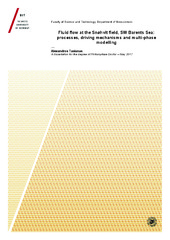Fluid flow at the Snøhvit field, SW Barents Sea: processes, driving mechanisms and multi-phase modelling
Permanent lenke
https://hdl.handle.net/10037/11494Åpne
Thesis (PDF)
Paper 4: Tasianas, A., Koukouzas, N., Gemeni, V., Alexopoulos, D., Vasilatos, C.: “ Geological modelling for investigating CO2 emissions in Florina Basin, Greece”. Also available in Open Geosciences 2015, 7(1): 465 - 489. (PDF)
Dato
2017-07-03Type
Doctoral thesisDoktorgradsavhandling
Forfatter
Tasianas, AlexandrosSammendrag
The research undertaken in this PhD project was part of a large EU interdisciplinary
project named ECO2: Sub-seabed CO2 Storage: Impact on Marine Ecosystems.
The overall goal of the ECO2 project was to understand the short-term and long-term
impacts of CO2 storage on marine ecosystems.
I concentrated my work on the Snøhvit site, which is located in the SW Barents Sea, on the Norwegian continental shelf, and more specifically in the ENE-WSW oriented Hammerfest Basin (HFB), which is about
130km off the coast of Finnmark, in northern Norway. Snøhvit, receives ~0.7 Million tons of CO2 per year and has been in operation since late 2008.
By injecting CO2 back into the earth and not leaving it to accumulate in the atmosphere,
through the process of Carbon Capture and Storage (CCS), we can put forward a potential and innovative way of reducing CO2 emissions and thus mitigate climate change.
My work mainly focused on the Snøhvit hydrocarbon field and CO2 storage site in the
Hammerfest Basin in the SW Barents Sea. The main basis of my work consisted of an
interpretation of conventional 3D and high-resolution P-Cable 3D seismic data that were
used to obtain a better understanding of deep-to-shallow fluid flow. I was mainly involved in work, which concentrated on the architecture and integrity of the
sedimentary cover at storage sites and in activities aiming at
coordinating the development of monitoring techniques and strategies. I also contributed to the development of a framework of best environmental practices in the management of offshore CO2 injection and storage.
Methodology used throughout the project included the use of new state-of-the-art technology, employed for an enhanced imaging of the seafloor and its sub-surface at unprecedented resolution. New P-Cable high-resolution 3D seismic imaging techniques provided us with more detailed images of subsurface architecture and enhanced detection of fluid leakage, which led to a better
understanding of the mechanisms of fluid flow through the sedimentary overburden of
CO2 storage sites.
The primary method employed in this thesis is thus seismic interpretation of both
conventional and P-Cable 3D seismic data using Schlumberger’s Petrel software. The
seismic interpretation consisted of mapping key reflectors located in the Snøhvit
subsurface and deriving volume-based attribute information, like RMS amplitude or
variance. Interpreted horizons were then used to construct surfaces and layers, which
were subsequently populated with geological properties.
Abundant and widespread fluid flow can be observed in the SW BS. The observed fluid flow features can be of various types, interpreted as gas chimneys, leakage along faults and fractures and other related
features. Although fluid migration has taken place in the past in the study area, we
clarify that at present, there is no active seepage of gas in the Snøhvit area.
Beskrivelse
The papers 1, 2, 3 and 5 of this thesis are not available in Munin.
Paper 1: Tasianas, A., Martens, I., Bünz, S., Mienert, J.: «Mechanisms initiating fluid migration at Snøhvit and Albatross fields, Barents Sea”. Available in Arktos 2016, 2(26).
Paper 2: Tasianas, A., Bünz, S.: “High-resolution 3D seismic study of pockmarks and shallow fluid flow systems at the Snøhvit hydrocarbon field in the SW Barents Sea”. (Manuscript). Published version available in Marine Geology 2018, 403, 247-261.
Paper 3: Tasianas, A., Mahl, L., Darcis, M., Bünz, S., Class, H.: “Simulating seismic chimney structures as potential vertical migration pathways for CO2 in the Snøhvit area, SW Barents Sea: model challenges and outcomes”. Available in Environmental Earth Sciences 2016, 75 (504).
Paper 5: Tasianas, A., Buenz, S., Vadakkepuliyambatta, S., Mienert, J.: “Buried subglacial landforms in the SW Barents Sea imaged using high-resolution P-Cable seismic data”. Available in Dowdeswell, J. A., Canals [et. al.] (eds.): Atlas of Submarine Glacial Landforms: Modern, Quaternary and Ancient”. Geological Society, London, Memoirs 2016, 46, 183–184. ISBN: 978-1-78620-268-0.
Paper 1: Tasianas, A., Martens, I., Bünz, S., Mienert, J.: «Mechanisms initiating fluid migration at Snøhvit and Albatross fields, Barents Sea”. Available in Arktos 2016, 2(26).
Paper 2: Tasianas, A., Bünz, S.: “High-resolution 3D seismic study of pockmarks and shallow fluid flow systems at the Snøhvit hydrocarbon field in the SW Barents Sea”. (Manuscript). Published version available in Marine Geology 2018, 403, 247-261.
Paper 3: Tasianas, A., Mahl, L., Darcis, M., Bünz, S., Class, H.: “Simulating seismic chimney structures as potential vertical migration pathways for CO2 in the Snøhvit area, SW Barents Sea: model challenges and outcomes”. Available in Environmental Earth Sciences 2016, 75 (504).
Paper 5: Tasianas, A., Buenz, S., Vadakkepuliyambatta, S., Mienert, J.: “Buried subglacial landforms in the SW Barents Sea imaged using high-resolution P-Cable seismic data”. Available in Dowdeswell, J. A., Canals [et. al.] (eds.): Atlas of Submarine Glacial Landforms: Modern, Quaternary and Ancient”. Geological Society, London, Memoirs 2016, 46, 183–184. ISBN: 978-1-78620-268-0.
Forlag
UiT Norges arktiske universitetUiT The Arctic University of Norway
Metadata
Vis full innførselSamlinger
Copyright 2017 The Author(s)
Følgende lisensfil er knyttet til denne innførselen:


 English
English norsk
norsk
